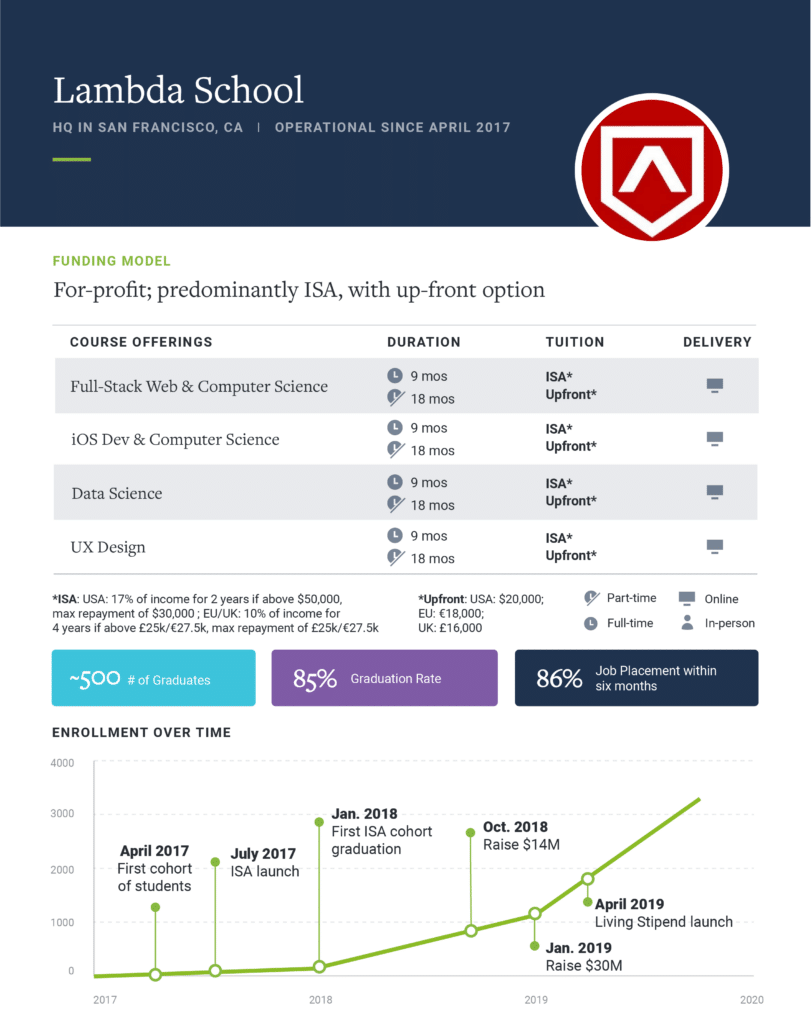Bootcamps focused on coding and computer science have emerged as an important pipeline for tech talent. We conducted in-depth interviews with seven leading bootcamps to better understand their outcomes-focused business models. We are now sharing their stories, this being the fifth bootcamp profile. For more on these models’ disruptive potential, read our recent paper, Betting on Bootcamps.

Austen Allred embarked on the traditional educational route, but lost patience with the time and cost needed to earn a computer science degree. Before long, he dropped out to pursue work in the world of start-ups and fintech—and found that the degree he had been chasing wasn’t necessary after all. Meanwhile, his brother was teaching at a coding bootcamp, piquing Allred’s interest in the model. He noted that while students in major cities had a plethora of bootcamp options, rural students had few, if any, at hand. In 2017 he founded Lambda School, a fully online, synchronous bootcamp that charged $10,000 upfront.
While the business grew quickly, Allred noted that many prospective students chose not to enroll for financial reasons. Early feedback revealed that for many, it wasn’t necessarily about the dollar amount—many were deterred by the risk of shelling out thousands of dollars and later not getting a well-paying job. The Lambda team thus got to work on a model that would spare students the financial risk of an education experience that did not pay off, implementing income share agreements (ISAs) to make this a reality. In July 2017, Lambda School transitioned into its current ISA model, in which students pay nothing initially but agree to pay Lambda School a fixed percentage of their income within a set number of years once employed.
Lambda School also changed its course offerings. Initially, the company only taught a single course, web development, with a duration of roughly four months. But a critique was emerging from employers and in the media about coding bootcamp graduates: they knew how to code, but didn’t have a strong theoretical foundation. In response, the school added data structure and algorithms components to the course. In order to incorporate the additional material, Lambda School has experimented with extending its course length, stretching first to six months, then to 30 weeks, and most recently to nine months in March 2019. “In a way, the curriculum more closely mirrors a computer science degree with some non-programming material stripped out,” said Allred.
Lambda School has also expanded beyond web development. The company offered a machine learning and artificial intelligence course that morphed into a Data Science track in early 2018. Throughout the rest of the year, Lambda added iOS and Android development courses, as well as a UX Design course.
Steady growth, steady student engagement
In spite of, or perhaps because of, Lambda’s iterative process of developing its offering, the school has grown steadily. In 2018, its second year of operation, Lambda enrolled over 1,000 students. By the end of 2019, the company expects to enroll over 4,000 students. Initially confined to the US, Lambda began offering its courses to students in Europe in January 2019.
For all courses, students have two payment options: either paying all tuition ($20,000) upfront, or entering into an ISA. The vast majority of students—approximately 98 percent—enter into an ISA, the terms of which vary depending on the student’s country of residence.
In the US, students earning more than $50,000 annually make up to 24 monthly payments of 17% of their income. The contract is satisfied once either: the student makes 24 payments; the student reaches the payment cap of $30,000; or five years elapse, even if the student pays nothing. It works similarly in the EU and UK, but with different numbers. Students pay 10% of their salary for 48 monthly payments once earning over £25,000 or €27,500.
One challenge that comes with implementing ISAs is the time it takes for revenue to trickle in—upfront tuition is paid before a student even sets foot in the door, but ISA repayment takes years, and doesn’t start until the student finishes the program. This aligns incentives between the education provider and the student by making the school’s revenue contingent on students finishing the program and earning a good salary. But it also creates a working capital gap, which Lambda School has addressed through a combination of venture capital funding rounds and third-party financing providers. The company raised over $48 million from venture capital firms for the stated purposes of funding learners’ upfront costs, as well as increasing enrollments, scaling internationally, and expanding into new fields.
Implementing ISAs is one of several factors that pushes Lambda to iterate heavily on its fully-online model. “Instructional design has to be basically perfect to keep students engaged,” explained Allred. “It was a real challenge getting it right, but now it works. We see no reason to establish a physical presence.”
Being fully online and not requiring students to relocate facilitates a form of self-paced education for Lambda School students. Learners who are progressing more slowly can fall behind their scheduled cohorts and join later ones as needed, giving them time to master concepts before progressing to new ones. Given that the company enrolls new cohorts every five or six weeks, students have considerable flexibility on this front. Further, the lack of a physical campus lets Lambda bring in instructors, predominantly hired out of their respective industries, from all over the country, as they all teach remotely.
An “economic clearinghouse”
Lambda School consults employers throughout its curricular development and creation process. The company assesses employer needs through advisory boards and consultations with field experts and hiring managers in order to create new courses and update existing ones. As this research surfaces employer-desired skills and abilities, Lambda can then work backwards to develop and evolve its curricula.
Allred does not want integration with employers to stop at curriculum development, however. “Lambda School started out as a bootcamp but has quickly matured into a new category of higher education. Long term, I view Lambda School as an economic clearinghouse,” he explained. “An employer should be able to request a custom order for a certain number of employees, and Lambda will find and train those students accordingly.” To that end, Lambda developed an endorsement program that guarantees students interviews with matched hiring partners, in addition to weekly sessions with industry mentors.
Looking at the most recent outcomes report published through CIRR, Lambda School does show that for the first half of 2018, roughly 51 percent of students graduated on time (back when the course was six months long), with another 27 percent taking an additional three months to graduate, at no additional cost. For that same period, 85.9% of graduates were employed in-field within six months of graduation, earning a median salary of $60,000. Lambda School reports on its website an overall hire rate of 83 percent within six months of graduation, with a median salary of $70,000. As of February 2019, all graduates from Lambda School’s first cohort have landed software engineering jobs.
Going forward, Lambda School is reportedly looking to offer courses in cybersecurity, a burgeoning field in the bootcamp space; and medicine, a field that excites many but has proved elusive thus far. Allred is also hoping to expand into Canada, as well as more countries in Europe, focusing first on areas with more widespread acceptance of ISAs. An open question is whether Lambda School will also partner with traditional institutions of higher education. “We have a couple of schools reaching out to partner with us,” said Allred. “That door is open if we decide to walk through it.”
Our previous bootcamp profiles:



